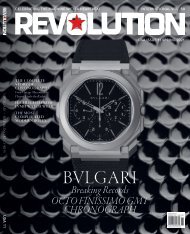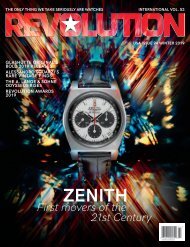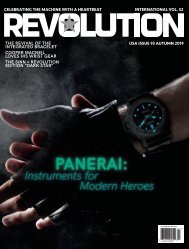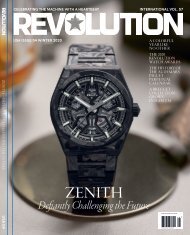You also want an ePaper? Increase the reach of your titles
YUMPU automatically turns print PDFs into web optimized ePapers that Google loves.
this. As a comparison, of the Ferrari 250 GTOs in existence, almost all of them have crashed<br />
and had significant work performed on them for one simple reason: these were race cars and<br />
the people who owned them used them as such. It’s the same for Rolexes: in the era before a<br />
200-percent markup on the aftermarket on steel watches was the norm, these were tool watches<br />
used by professional drivers, explorers, divers and soldiers, and it makes sense that these watches<br />
saw some amount of hard use. My only concern with all the available technology — in particular<br />
laser welding, which brings the original shape, including bevels, of a watch back to life — is when<br />
the resulting watches are passed off as NOS when clearly they are not.<br />
FINDING THE 1675 OCC PCG GILT DIAL<br />
OK, back to my Rolex GMT. My very first two vintage Rolex purchases differ dramatically. One<br />
was the 18K yellow-gold 6265 Daytona from the Davide Blei collection that I bought from a<br />
Patrizzi themed auction in 2009 ,and it has been nothing but a constant source of pleasure.<br />
The other vintage Rolex was what I now refer to as the Rolex GMT from hell — specifically, it’s<br />
a 1675 GMT watch with a special OCC dial. This watch has been nothing but a source of rage,<br />
anxiety and frustration from the moment it came into my life, because it’s been so fraught with<br />
half truths. The words “Officially Certified Chronometer” on the dial marks this watch as a<br />
transitional model from 1959 when its predecessor, the 6<strong>54</strong>2, was being phased out and the<br />
1675 model was introduced. By the later part of 1960, the dials on these watches were changed<br />
to read “Superlative Chronometer Officially Certified”, in deference to the COSC certification<br />
of the movements within. Dials from the 1675 do not fit on the 6<strong>54</strong>2, and vice versa, so the<br />
OCC 1675 does not feature the transplanted dial. Further, the words “Officially Certified<br />
Chronometer” refer to the caliber 1535 before the introduction of Rolex’s famous Microstella<br />
adjusters found on the balance wheel. (OCC dials have also been seen in this transitional period<br />
with the 1560 caliber.) Almost all OCC 1675 watches come with 1.60 stamped on the back,<br />
in reference to its manufacture during the first quarter of 1960. The serial range should be<br />
between 5032xx and 505xxx, while models in 1961 bore 680xxx serials.<br />
I purchased my GMT watch from an individual (we’ll call him ‘J’), a highly affable,<br />
entertaining and charming man. J is a bon vivant extraordinaire, a natural raconteur, a rare<br />
watch dealer, but also a journalist whom I believed to have been an incredible repository of Rolex<br />
information. He is, to this day, one of the more popular individuals on the London watch scene.<br />
Indeed when I shared with my former editor Tracey Llewellyn, who’s now at The Telegraph in<br />
London, that I’d been sold a highly questionable watch by J, she immediately leapt to his defence.<br />
However, from the onset, the watch I bought from him brought with it challenges, and that’s<br />
because I did something people rarely do when they buy a vintage watch from J: I sent it to a<br />
THIS SPREAD,<br />
CLOCKWISE<br />
The movement of our<br />
1675 OCC PCG bears<br />
Rolex’s 1560 caliber, a<br />
movement that was seen<br />
in transitional models<br />
of the watch along with<br />
the 1535 caliber. The<br />
1560 featured Rolex’s<br />
microstella adjusters<br />
on the balance wheel.<br />
On the right, the<br />
case number bears<br />
a matching series<br />
to the movement<br />
number and caseback.<br />
This is because the<br />
watches were created<br />
in specific batches,<br />
thus not all Rolex<br />
case numbers were<br />
assigned accordingly.<br />
PREVIOUS SPREAD,<br />
CLOCKWISE<br />
After polishing<br />
(Vintage Rollies did<br />
not laser weld this<br />
watch), the watch<br />
in its current state,<br />
showing how restoration<br />
can bring back the<br />
beauty of a watch.<br />
The Rolex 1675 before<br />
restoration by Vintage<br />
Rollies (@vintagerollies),<br />
showing its age.<br />
The restoration process<br />
is a combination<br />
of research and<br />
understanding each<br />
model, as well an<br />
appreciation of what<br />
should be restored, or<br />
remain untouched.<br />
VINTAGE 143











